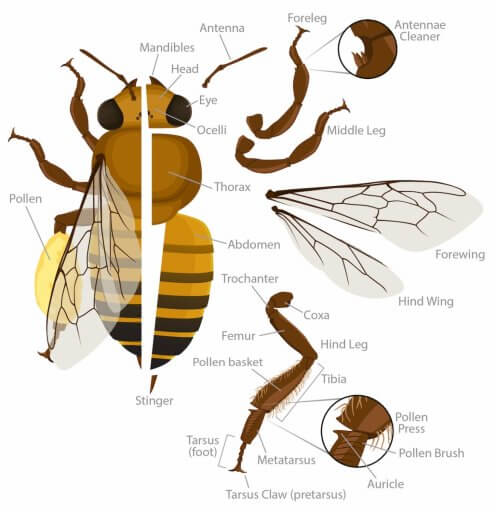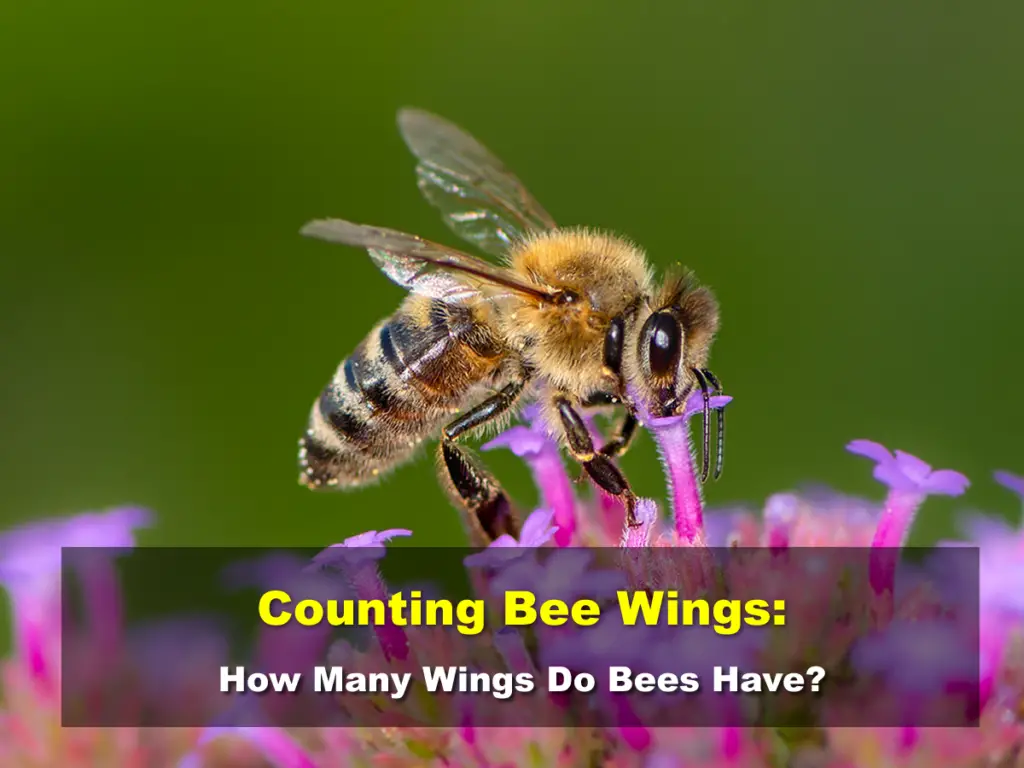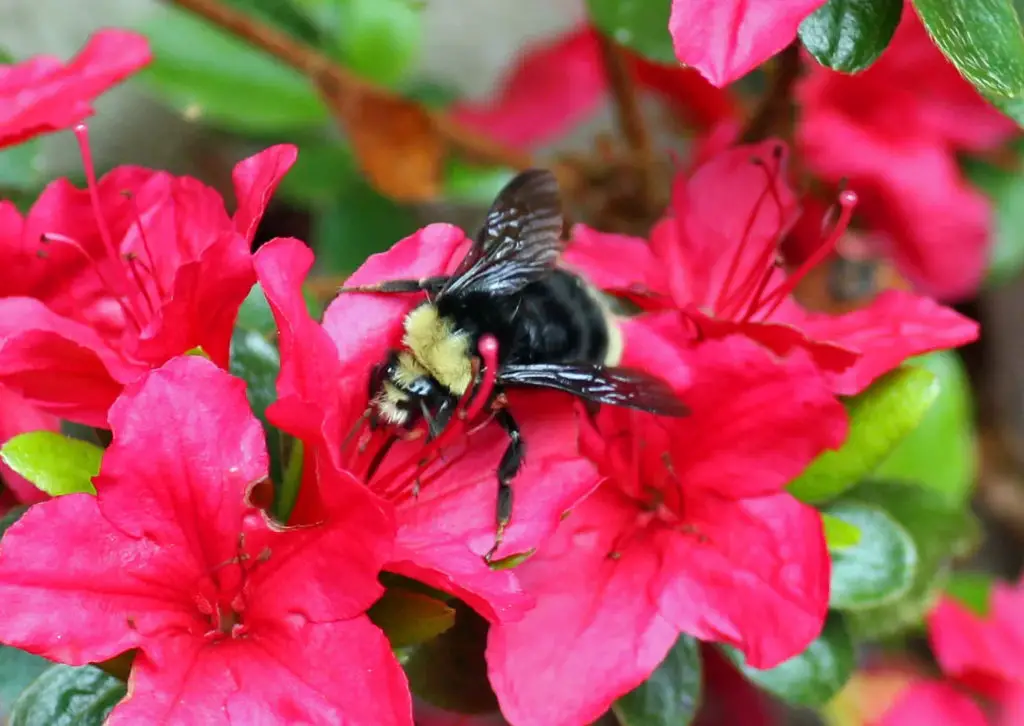Affiliate Disclaimer - As an Amazon Associate I earn from qualifying purchases.
It supports the website. So, Thank you
Bees are truly fascinating creatures and there are many different species. But one thing is the same between all bee species and that is the number of wings. So, how many wings do bees have?
A bee has four wings. Two of each type are on either side of the body. However, these wings are all latched together so they work as an amazing flight system.
One of the most interesting things about bees is that they don’t just use their wings for flying, although this is one of their main purposes. In this article, I’ll be looking at the anatomy of the bee wing and how these amazing creatures use them.
Table of Contents
Bee Anatomy 101
Before I start talking about the wings of a bee, I’d like to spend a little time helping you familiarize yourself with their general anatomy. This will come in handy when I start talking about the location of the wings and other interesting facts.
Being insects, the body of the bee is made up in a very similar way to other insect species; with three separate parts. These include the thorax, the abdomen, and the head.
At either side of the thorax, we find the bee’s legs and there are three on each side, totalling six.
On the very back of the abdomen we find the bee’s stinger although it’s worth noting that there are around 550 of the 20,000 bee species that do not have a sting. These are called stingless bees. Where bees do have a stinger, this is used as a form of self-defense, usually when the bee feels as though its colony is under threat.
Another interesting part of the bee’s anatomy is its tongue which is called the proboscis and is a straw-like structure that the bee uses to slurp nectar from the flowers it visits as well as for collecting water.
On the head, we also find two antennae that the bee uses to sense things including touch and smell. They also have five eyes on the head; two compound eyes at the sides as well as three simple eyes closer to the top of the head. (You can read my article on bee eyes here.)

How Many Wings Do Bees Have?
So, let’s get down to the main order of business; bee wings!
A bee has four wings with two located on either side of the thorax which is the upper part of the insect’s body. The forewings are the larger two while the hindwings are slightly smaller but they are all connected to one another when the bee flies thanks to a row of hook-like structures which are known as the hamulus.
What Are Bee Wings Made Of?
Bees’ wings are made of chitin. This is a fibrous natural material which can also be found in the outer shells of beetles and other places in nature. In bees, chitin is also what the main wall of the bee’s body is made from and with the wings, this creates something of an exoskeleton.
While the wings might look pretty simple, they’re actually made from three different layers. The first layer is a thin membranous sheet that’s not all that dissimilar to your fingernail. The central layer contains all of the blood vessels and nerves while the final base layer is made of the same material as the top layer. Together these two outer layers protect the more delicate second layer.
As well as the main chitin structure, bee wings also contain an elastic protein known as resilin which is what the wing joints are made from. This allows the wings to be more flexible and prevents them from breaking due to trauma.
What’s amazing is that this construction means that bee wings are a lot stronger than you might first imagine. For example, a bee can fly into an object without damaging its wings thanks to the resilin in the joints. That said, they’re not indestructible and, over time and with age, the wing quality does begin to deteriorate.
In the case that a bee breaks its wing, it is damaged for life as there’s no way that the bee can regrow or repair it. This can significantly affect their foraging abilities and their role within the hive.
The wing of a bee usually measures around 9-10 mm and they have a translucent color.
Where Are The Bees Wings Located?
As I have mentioned, the bee’s wings are located on the upper part of the body called the thorax. This sits between the abdomen (which is usually the part with markings) and the head. It’s also here that you’ll notice a lot of fuzzy little hairs in many species.
The placement of the wings is perfect because the thorax contains many muscles that allow the bee to take flight. These are known as asynchronous muscles and enable the bee to beat its wings at an astonishing rate of 230 times per second!
In order to move the wings, there is a vertical set of thorax muscles which pull the wings from the top while a set of horizontal muscles control the ends of the wing.
When the bee is in flight, you’ll notice that the forewings are placed on top of the hindwings but when the bee lands, the two separate. This is possible because of those hook-like structures I mentioned earlier and they’re used to attach the two wings together. The bee does this just before it takes off in a process known as wing-coupling.
What Do Bees Use Their Wings For?
The primary reason that bees have wings is to allow them to fly. When they flap their wings, this is what creates that iconic buzzing sound that tells you a bee is near. And it’s no wonder it’s noisy when you consider how quickly their wings beat.
But flight isn’t the only thing that these critters use their wings for. For example, in the hive, worker bees will flap their wings in order to remove excess moisture from honey. By doing this, the honey becomes much more long-lasting and it’s even reported that this is a food that never spoils!
Something I find truly fascinating about bees is the way in which they communicate. They use several methods and one of these includes the wings. You may have heard of the waggle dance that honey bees perform to show other members of the colony where the best food sources are. While they primarily use their bodies for this dance, they’ll also flap their wings to tell others how close the food source is.
If that wasn’t enough, consider that bees also use their wings to regulate their body temperature. In order to fly, bees need optimal conditions and that includes the right temperature. To achieve this, a honey bee will move its wings to adjust its temperature in the same way that a human would shiver to warm up.
Their wings also come in handy when they’re inside the hive because they’ll use this flapping motion to control the hive temperature to make it suitable for raising young and to encourage the queen to lay her eggs.
You may have seen bees struggling to get out of water and that’s because they’re not the best swimmers. But should they find themselves at the deep end, all is not lost because they can use their wings to propel themselves to the edge and climb out.
How Fast And How Far Can A Bee’s Wing Take It?
One of the most amazing things about bees is how far they can travel. In a worker bee’s life, she may fly up to 500 miles before her wings start to become so battered and broken that she can no longer. Even in a single foraging flight, a worker honey bee may travel as far as five miles. Although it’s more normal for them to stay within a mile of the hive except when food sources are low, she’ll go further afield.
Generally speaking, female worker bees can live anywhere between one and two months but you may have heard that queen bees live much longer. This is true and some can live for up to three years.
Much of this has to do with the fact that the queen remains inside the hive and only takes on flight for mating in her entire life. This means that she expends much less energy by flapping her wings so is able to survive for longer.
You might think that the same could be said for drone bees because they also remain in the hive apart from mating. But where a worker bee is busy flapping her wings up to 230 times a second, drones are quite lazy.
But this lower consumption of energy means nothing because, once a drone has successfully mated with the queen, he dies. And if he doesn’t mate, he’s shunned from the hive and won’t survive for long on his own.
Final Thoughts
Bees may be small but they have bodies that are perfectly adapted to their way of life and that includes their wings. If you’ve ever wondered how many wings a bee has, then the answer is four.
The most amazing thing is that while the wings are used for flight, this isn’t their only purpose. They’re an extremely versatile body part!




